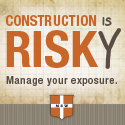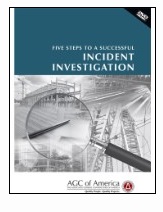AWARENESS IS THE FIRST STEP
The global green building sector continues to double every three years, with survey respondents from 70 countries reporting 60 percent of their projects will be green by 2018, according to a Dodge Data & Analytics World Green Building Trends 2016 SmartMarket Report.
"Several years ago, contractors saw green building strategies as a way to grow their business by offering a unique approach to building, but today, energy efficiency, LEED certification and green buildings are more of the norm," says Erik Wenstone, ARM, vice president of CMR Risk and Insurance Services.
"Ninety-five percent of our projects are pursuing LEED certification or custom sustainability goals," says Jennifer Frey, sustainability program manager, Sellen Construction Company, Inc., an AGC of Washington member. "Clients are motivated to compete in their market against other LEED projects."
Two ways this green movement, however, can add to the liability risk for contractors are with greater performance objectives in a green building, as well as an emphasis on ever more sustainable new technologies and materials that push the envelope. Incentives meant to reward green building can also add a layer of risk. According to Wenstone, if the contract promises a Gold LEED rating but delivers a building with a Silver LEED rating, the owner could lose benefits such as tax credits, zoning allowances and other incentives tied to the higher rating.
The liability for green-related factors doesn’t end when the building is turned over to the owner. If the contract specified energy savings – if the design is modeled to achieve a 30 percent savings compared to baseline, but the building saves significantly less energy or worse is an "energy hog," for example – the fear is that an owner may claim fraud in advertising or negligent misrepresentation and come after the contractor. Although several factors may be in play when a building’s actual performance doesn’t match up to how it was modeled (e.g., changes in building use, higher plug loads, or deficient operations and maintenance), discrepancies will call into question what went wrong and who is responsible. Actual performance is expected to become more important as green building standards call for increased monitoring and measurement, and as building owners strive to achieve net zero energy buildings.
"Net zero is definitely the top trend and is becoming more feasible for medium-sized projects," says Hamp Sterling, environmental manager, W. G. Yates and Sons Construction Company, an Arkansas Chapter member.
Education is key, says Wenstone. "Minimize risk with education about green building practices and awareness of liability exposures in the contract that traditional building practices don’t typically incur."
Two ways green construction changes contractor risk include:
PROFESSIONAL LIABILITY
Wenstone recommends that while many contractors elect not to carry professional liability coverage, they should discuss it with their risk professional if they are seeking out green building projects. "Coverage for errors and omissions is considered essential for engineers and architects, but other non-design contractors don’t often feel the coverage is necessary," he says. Be aware that if a system or performance metric is not met, an owner can come back to all contractors who were responsible for the system.
NEW TECHNOLOGIES
When using a technology you have not used before, it’s important to review coverage and exposures with an insurance broker, suggests Wenstone. For example, a roofing contractor’s policy may exclude subsidence, which for the most part is not an issue for a traditional roofing contractor. However, putting in a vegetative roof can raise the issue of earth movement. "The additional weight of the vegetative roof could create structural integrity issues that could result in third-party property damage due to the weight of the roof or post-installation settlement that causes the building to move," he explains.
The use of new materials also can be an area of concern evidenced by the case involving the first-ever LEED Platinum building, which was embroiled in litigation for a decade in part over the unconventional use of a "green" material. Green building materials are advancing rapidly and growing increasingly transparent in the process. It is important to keep in mind, though, new movements toward greater disclosure – such as environmental product declarations or health product declarations – relate to how materials may impact the environment or human health and do not attest to how well a product will perform in a certain application.
As a general rule, the greater the unknowns related to a project, either with the technology or materials used, the greater the potential risk of construction defects and other claims that the contractor will need to protect themselves against.
"The area of risk and liability related to green building is evolving, and I believe we will learn more about what risks exist as more buildings are LEED certified and as green building practices expand," says Wenstone.
In the meantime, Wenstone offers the following advice to help contractors minimize their liability exposure on green projects:
CRAFT CONTRACTS CAREFULLY
Be sure you can deliver what you promise, do not over promise, and be aware of delays in delivery of green-related equipment and materials due to the low number of manufacturers in the industry. Work with an attorney who understands risks associated with green buildings and critical areas of any contract that need to be altered or clarified — especially related to "promises" of energy performance outside of the contractor’s ability to control. Contractors working on green buildings will need to invest the time and staff resources into knowing what falls within their responsibility –and making sure the contract reflects that.
LEED CERTIFICATION
Take a course about LEED certification for buildings or have project managers achieve professional accreditation for the LEED rating system that covers the type of work your company will perform (e.g., green associate for general knowledge, BD+C specific to building design and construction for new construction). A thorough understanding and awareness of the scoring system for the rating levels as well as the options to obtain points better prepare a contractor to develop a contract that minimizes exposure. The contractor responsibility for many credits is tied closely to quality assurance during construction (e.g., energy optimization); for some credits, the contractor must fulfill the objective (e.g., implement a construction and demolition waste management plan). Knowledge of the credits will go a long way toward clarifying and assigning responsibility. Another area where training is important is with LEED
documentation. Certification requires a lot of documentation related to the prerequisites and credits that a contractor will play a role in collecting, maintaining, and submitting. Some of this documentation is impossible to recreate afterwards, so it is important to know what you need to collect and to collect it as you go.
REVIEW INSURANCE COVERAGE
Don’t wait for an annual insurance review when bidding on a green project for the first time. Work with a broker who can spot the potential risks that accompany LEED certification buildings based on your specific work to ensure all necessary coverages and risk controls are in place.
AGC’s annual Contractors Environmental Conference regularly includes sessions on green building and sustainability. The 2016 CEC is Oct. 5-6, in Washington, D.C. Go to http://meetings.agc.org/cec/ to see the schedule and topics. You can also follow AGC’s Environmental Services for news about compliance and sustainability on Twitter at https://twitter.com/AGCEnvironment. 
 2300 Wilson Boulevard, Suite 300 · Arlington, VA 22201 · 703-548-3118 (phone) · 703-548-3119 (fax) · www.agc.org
2300 Wilson Boulevard, Suite 300 · Arlington, VA 22201 · 703-548-3118 (phone) · 703-548-3119 (fax) · www.agc.org
 Submit Your Application for the 18th Annual Willis Towers Watson Construction Safety Excellence Awards
Submit Your Application for the 18th Annual Willis Towers Watson Construction Safety Excellence Awards



 Companies need guidance on how to investigate a job site accident properly. This program helps you better prepare contractors for investigating accidents on their jobsite, including root cause analysis. Accidents occur on construction jobsites every day. The failure of people, equipment, supplies, or surroundings causes most of them. Incident investigations determine how and why these failures occur. By using the information gained through an investigation, a similar, or perhaps more disastrous, accident may be prevented. It is important to conduct incident investigations with prevention in mind and not blame. Pack 0470Dage includes a twenty-two minute DVD video and one booklet.
Companies need guidance on how to investigate a job site accident properly. This program helps you better prepare contractors for investigating accidents on their jobsite, including root cause analysis. Accidents occur on construction jobsites every day. The failure of people, equipment, supplies, or surroundings causes most of them. Incident investigations determine how and why these failures occur. By using the information gained through an investigation, a similar, or perhaps more disastrous, accident may be prevented. It is important to conduct incident investigations with prevention in mind and not blame. Pack 0470Dage includes a twenty-two minute DVD video and one booklet.